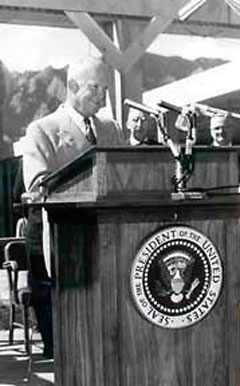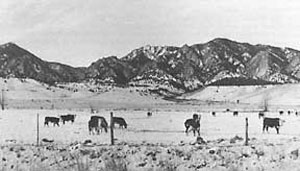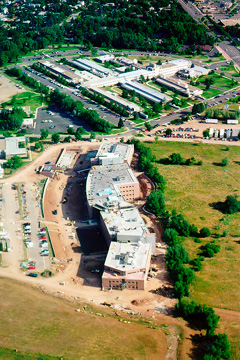| NOAA Magazine || NOAA Home Page |
 October
1, 2004 — Fifty years ago this month, President Dwight D. Eisenhower
stood at a podium in Boulder, Colo., with the famous Flatirons rock formation
in the scenic background. He rose to dedicate a building that was to serve
as the new home for an area of science that was expanding after the war
— radio waves and their propagation in the atmosphere. This research
was important militarily, and in the areas of telecommunications, understanding
solar activity and its affects on the Earth, and the dynamics of the
upper and lower atmosphere.
October
1, 2004 — Fifty years ago this month, President Dwight D. Eisenhower
stood at a podium in Boulder, Colo., with the famous Flatirons rock formation
in the scenic background. He rose to dedicate a building that was to serve
as the new home for an area of science that was expanding after the war
— radio waves and their propagation in the atmosphere. This research
was important militarily, and in the areas of telecommunications, understanding
solar activity and its affects on the Earth, and the dynamics of the
upper and lower atmosphere.
Thus began a proud history of exploration and discovery in the atmospheric sciences at Boulder facilities and institutions that would eventually evolve into six of the 12 NOAA environmental research laboratories, as well as two of its university partners at the University of Colorado and Colorado State University. It also was the foundation for the NOAA National Geophysical Data Center, the local NOAA National Weather Service and the NOAA Mountain Administrative Support Center.
History
of the Boulder Labs
A
few years before the President attended that sunny September ceremony
(it is told that he was on a golf vacation with his in-laws, Mamie's Denver
family), a newly created laboratory — the Central
Radio Propagation Laboratory — was looking for a home.
 In
the late 1940s and at the beginning of the Cold War, President Truman
had declared that new government facilities should not be built within
the Washington, D.C., metro area so as not to concentrate so many federal
facilities within range of an atomic bomb. As recollected by 85-year-old
Alan H. Shapley, a longtime Boulder resident who joined the CRPL in 1947,
Congress had appropriated funds for the lab and it was established within
the National Bureau of Standards in 1946. (Shapley served as director
of the now NOAA Geophysical Data Center in Boulder from 1972 to 1981.)
In
the late 1940s and at the beginning of the Cold War, President Truman
had declared that new government facilities should not be built within
the Washington, D.C., metro area so as not to concentrate so many federal
facilities within range of an atomic bomb. As recollected by 85-year-old
Alan H. Shapley, a longtime Boulder resident who joined the CRPL in 1947,
Congress had appropriated funds for the lab and it was established within
the National Bureau of Standards in 1946. (Shapley served as director
of the now NOAA Geophysical Data Center in Boulder from 1972 to 1981.)
For the new lab's permanent home, however, Shapley said the general consensus was that it should be located near a major university and within commuter plane distance to the District of Columbia for lab scientists and administrators who needed to check in regularly with their bosses. The University of Virginia at Charlottesville was mentioned as a possibility.
A
New Home in Boulder, Colo.?
At
about the same time, Shapley recalled, Walter Orr Roberts — founding
president of the University Corporation
for Atmospheric Research and the first director of the National
Center for Atmospheric Research (now an important research collaborator
with NOAA) had been collecting solar observations from an observatory
high in the Colorado Rockies. After the war, Roberts decided to move the
high-altitude facility closer to
Boulder, and now it is part of NCAR. Roberts contacted scientists at the
CRPL, and the then-director of the NBS (who also had Colorado connections)
and asked that a delegation be sent to Boulder to see whether the lab
might be moved "out West."
Shapley said many of the folks involved in these areas of science (i.e., solar-terrestrial disturbances, high atmospheric dynamics and radio wave propagation studies) lived and were schooled in the eastern United States. The prospect of moving "west of the Hudson (River)," let alone 1,800 miles from the East Coast to "a scientific Siberia," was not regarded as such a grand idea by some, he recalled.
 Site
Visit Out West
Site
Visit Out West
A
site-inspection delegation (including Shapley) winged its way to Colorado
in 1949, in a DC-6 that
Shapley described as a popular commercial aircraft at the time. It featured
a lounge in which passengers could relax and visit. The delegation "had
a huddle in the lounge," he said, and decided to present a unified
front in Colorado — they agreed that they would recommend Boulder
as the site for the CRPL.
Nevertheless, and probably not knowing that a decision had all but been made already, the Boulder Chamber of Commerce and city officials "brought out the heavy-hitters" to lobby the delegation when they arrived in town. A reception was held at Roberts' home near the Flatirons, and all the stops were pulled, Shapley said.
The
Appeal of Boulder
Later,
Shapley said, an official site-selection committee was appointed, and
they drew up requirements for the CRPL location. They were looking at
Boulder, as well as Stanford and a site in Mississippi, but Colorado had
"two trump cards," said Shapely — land donated by businesses
and citizens through a Chamber fund-raising effort, and "Big Ed Johnson,"
Colorado's influential senator.
Eisenhower
Dedication of Department of Commerce Labs in Boulder
 Thus
it was that President Dwight D. Eisenhower (the first incumbent president
ever to visit Boulder) stood at a podium Sept. 14, 1954, and dedicated
the new home of the CRPL in Boulder, Colo. Schools and businesses closed
so nearly 10,000 citizens and dignitaries could attend the ceremonies.
Thus
it was that President Dwight D. Eisenhower (the first incumbent president
ever to visit Boulder) stood at a podium Sept. 14, 1954, and dedicated
the new home of the CRPL in Boulder, Colo. Schools and businesses closed
so nearly 10,000 citizens and dignitaries could attend the ceremonies.
In 1965, CRPL moved from NBS to join other agencies in the new Environmental Science Services Administration, and in 1970, ESSA became the National Oceanic and Atmospheric Administration. This change brought several groups into one agency to provide atmospheric, marine and oceanic services.
Another reorganization in 1967 created the Institute for Telecommunication Sciences, which became part of the National Telecommunications and Information Administration in 1978. On Aug. 23, 1988, the National Bureau of Standards was renamed the National Institute of Standards and Technology. Today, NOAA, NTIA and NIST make up the DOC Boulder campus.
Eight years
later (1973), in a move to consolidate NOAA’s Boulder entities on
the DOC campus site, construction of the David
Skaggs Research Center was completed and dedicated on Nov. 20, 1998.
Named after the former Boulder Congressman, the David Skaggs Research
Center would house over a thousand NOAA employees from the NOAA National
Geophysical Data Center, NOAA Mountain Administrative Support Center,
local NOAA National Weather Service and six of the 12 NOAA Environmental
Research Laboratories:
- NOAA Aeronomy Laboratory
- NOAA Climate Diagnostic Center
- NOAA Climate Monitoring and Diagnostics Laboratory
- NOAA Environmental Technology Laboratory
- NOAA Forecast Systems Laboratory
- NOAA Space Environment Center
Staff from one of NOAA’s Joint Research Institutes, the Cooperative Institute for Research in the Environmental Sciences, also work at the David Skaggs Research Center. CIRES is a cooperative institute between NOAA and the University of Colorado. Physically located on the University of Colorado Campus (Boulder, Colo.), this institute focuses on research involving environmental chemistry and biology, atmospheric and climate dynamics, cryospheric and polar processes and the solar-terrestrial environment. It is also important to note that many of the staff working at another NOAA Joint Research Institute, the Cooperative Institute for Research in the Atmosphere (a cooperative institute between NOAA and Colorado State University located in Fort Collins, Colo.), also work in Boulder, Colo.
Highlights
of NOAA Research laboratories' work in Boulder:
- 1965: NOAA's Space Disturbance Forecast Center begins routine daily forecasting service with the U.S. Air Force Air Weather Service, a relationship that continues today.
- 1968: NOAA takes over air sampling and analysis of atmospheric carbon dioxide, today the longest modern data record showing increases of this greenhouse gas in the atmosphere.
- 1975: NOAA develops the first doppler radar wind profiler to measure winds up to 10 kilometers, resulting in improvements to daily weather forecasts and warnings.
- 1979: NOAA research in Boulder begins collaboration with the National Weather Service to develop forecasting infrastructure to improve the nation's operational weather services.
- 1981: NOAA's high-energy pulsed doppler lidar (using optical rather than radio frequencies) for atmospheric wind measurements monitors winds during landing of the second space shuttle flight.
- 1986: NOAA scientist proposes that the cause of the Antarctic ozone hole is the interaction of human-produced chlorine compounds with ice clouds in the upper atmosphere; scientists from NOAA lead the first National Ozone Expedition to the South Pole that proves the theory correct, propelling international efforts to protect the ozone layer.
- 1988: In support of National Weather Service modernization, NOAA scientists develop a meteorological workstation that becomes the prototype for the system now operating in every weather office around the country.
- 1994: The NOAA Rapid Update Cycle weather forecast model becomes the NOAA National Weather Service's first forecast model using isentropic coordinates in the vertical and high frequency data for aviation, severe weather and general forecasts.
- 1993: NOAA establishes the first national network to monitor the broad spectrum of solar radiation and Earth's emitted radiation at the Earth's surface; the network is used to validate data from environmental satellites and weather forecast models.
- 1997: NOAA researchers help predict climate impacts of the 1997-98 El Niño.
- 2003: NOAA wind profiler network helps NASA track debris from space shuttle Columbia accident.
Thanks to
the foresight of the people of Boulder 50 years ago, the DOC Boulder Laboratories
have had a place to advance the intertwined fields of radio and atmospheric
research well beyond what its founders could have ever imagined. In return,
DOC and NOAA scientists have helped to bring international recognition
to the community, and the presence of the labs has helped steer Boulder’s
economic and cultural development. One can only speculate about what will
be achieved in the next 50 years.
Relevant
Web Sites
Ike
Liked the Labs -- How a "Scientific Siberia" Became the Hub
of U.S. Atmospheric Research
Timeline of the Labs in Boulder
Boulder Laboratories 50th Anniversary
Significant Papers from the First 50 Years of the Boulder Labs
Media
Contact:
Jana
Goldman, NOAA Research, (301)
713-2483